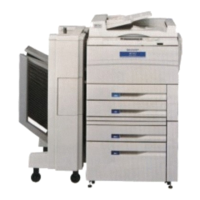5. Setting input activation
SIMULATION NO.XX-XX
X X X X SETTING [XXX] : XXX
(XXX~XXX)
INPUT SETUP VALUE AND PRESS PRINT SW
In the setting input screen, the effective range is indicated in ( ) and
the current setting is indicated in [ ]. Behind the “:” is an input field
where the cursor blinks to prompt the operator to enter data.
• If there is no entry of data in the input field:
a Press [PRINT] to sound the error buzzer to prompt the
operator to enter data. (In the case where the system is set for
“Key click sound ON”.)
b Pressing the [PAUSE] key returns the screen to the preceding
screen, without setting any data.
[Note] The main code/sub code are not cleared.
• If there is the entry of data in the input field:
a If the entered data is valid, the current setting in [ ] on the
screen and in memory is updated by pressing the [PRINT] key.
(The current setting in [ ] is rewritten.) After that, the screen
returns to the preceding one.
[Note] The main code/sub code are not cleared.
b Data in the input field can be cleared by pressing [CLEAR].
The entry of data is displayed, starting at the leftmost part of
the field. If data of more than the specified digits is entered or if
any invalid key is pressed, the input error buzzer sounds and
the entry of that data or the key is ignored. (In the case where
the system is set for “Key click sound ON”.)
6. Exception processing
1 If any “trouble” is received during the execution of a simulation,
the trouble code is displayed on the 7-segment display and the
system waists for [CA]. The trouble main/sub code modes on the
7-segment display can be switched over by pressing [PRINT].
[Note] Any trouble code is not displayed during the execution of a
simulation.
2 If the [PAUSE] key is pressed during the execution of a simula-
tion, the simulation is immediately suspended and the screen
returns to the preceding one.
[Note] The main code/sub code are not cleared.
3 If [CA] is pressed during the execution of a simulation, the execu-
tion of the simulation is stopped and the simulation is terminated.
7. Simulation list
Main
code
Sub
code
Content Remarks
Write in
memory
Adjustment
range
S-01 Checks optical system.
S-01 01 Checks mirror activation of optical system.
S-01 02 Displays operating status of optical system sensor.
S-02 Checks RADF aging.
S-02 01 RADF aging test.
S-02 02 Displays the operating status of the RADF sensor.
S-02 03 Checks forward rotation of paper feed motor.
S-02 04 Checks reverse rotation of paper feed motor.
S-02 05 Checks forward rotation of transport motor.
S-02 06 Checks reverse rotation of transport motor.
S-02 07 Checks rotation of paper eject and inversion motor.
S-02 08 Checks paper feed solenoid activation.
S-02 09 Check inversion selenoid activation.
S-03 Checks sorter activation.
S-03 02 Displays the operating status of sorter sensor.
S-03 03 Checks the activation of the transport motor.
S-03 04 Checks the activation of the bin shift motor. SF-S15 only
S-03 05 Checks the activation of the fan motor.
S-03 06 Checks the activation of the gate solenoid.
S-03 08 Checks the activation of the staple motor. SF-S53N only
S-03 09 Checks the activation of the paper holder solenoid. SF-S53N only
S-03 10 Checks the activation of the guide bar motor. SF-S53N only
S-04 Checks the activation of the desk.
S-04 02 Displays the operating status of the desk sensor.
S-04 03 Checks the upper tray cassette size switch.
S-04 04 Checks the lower tray (LCC) cassette size switch.
S-04 06 Checks the activation of the transport motor.
S-04 07 Checks the activation of the upper tray lift-up motor.
S-04 08 Checks the lift-up operation of the lower tray (LCC) cassette.
9 – 2

